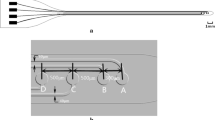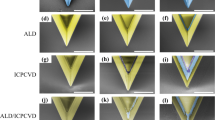Abstract
The lifetime of neural interfaces is a critical challenge for chronic implantations, as therapeutic devices (e.g., neural prosthetics) will require decades of lifetime. We evaluated the lifetime of wireless Utah electrode array (UEA) based neural interfaces with a bilayer encapsulation scheme utilizing a combination of alumina deposited by Atomic Layer Deposition (ALD) and parylene C. Wireless integrated neural interfaces (INIs), equipped with recording version 9 (INI-R9) ASIC chips, were used to monitor the encapsulation performance through radio-frequency (RF) power and telemetry. The wireless devices were encapsulated with 52 nm of ALD Al2O3 and 6 μm of parylene C, and tested by soaking in phosphate buffered solution (PBS) at 57 °C for 4× accelerated lifetime testing. The INIs were also powered continuously through 2.765 MHz inductive power and forward telemetry link at unregulated 5 V. The bilayer encapsulated INIs were fully functional for ∼35 days (140 days at 37 °C equivalent) with consistent power-up frequencies (∼910 MHz), stable RF signal (∼−75 dBm), and 100 % command reception rate. This is ∼10 times of equivalent lifetime of INIs with parylene-only encapsulation (13 days) under same power condition at 37 °C. The bilayer coated INIs without continuous powering lasted over 1860 equivalent days (still working) at 37 °C. Those results suggest that bias stress is a significant factor to accelerate the failure of the encapsulated devices. The INIs failed completely within 5 days of the initial frequency shift of RF signal at 57 °C, which implied that the RF frequency shift is an early indicator of encapsulation/device failure.





Similar content being viewed by others
References
R. Bhandari, S. Negi, L. Rieth, F. Solzbacher, A wafer-scale etching technique for high aspect ratio implantable MEMS structures. Sensors Actuators A Phys. 162, 130–136 (2010)
R. Biran, D.C. Martin, P.A. Tresco, The brain tissue response to implanted silicon microelectrode arrays is increased when the device is tethered to the skull. J. Biomed. Mater. Res. A 82, 169–178 (2007)
A. Branner, R.B. Stein, R.A. Normann, Selective stimulation and recording using a slanted multielectrode array (1999), p. 377.
A. Bulusu, H. Kim, D. Samet, and S. Graham Jr, Improving the stability of atomic layer deposited alumina films in aqueous environments with metal oxide capping layers. J. Phys. D Appl. Phys. 46, pp. 084014 1-10 (2013)
P.K. Campbell, K.E. Jones, R.J. Huber, K.W. Horch, R.A. Normann, A silicon-based, three-dimensional neural interface: manufacturing processes for an intracortical electrode array. IEEE Trans. Biomed. Eng. 38, 758–768 (1991)
P. F. Carcia, R. S. McLean, M. H. Reilly, M. D. Groner, and S. M. George, Ca test of Al 2O 3 gas diffusion barriers grown by atomic layer deposition on polymers. Appl. Phys. Lett. 89, pp. 031915 1-3 (2006)
P. F. Carcia, R. S. McLean, and M. H. Reilly, Permeation measurements and modeling of highly defective Al2 O3 thin films grown by atomic layer deposition on polymers. Appl. Phys. Lett. 97, pp. 221901 1-3 (2010)
C.A. Chestek, V. Gilja, P. Nuyujukian, R.J. Kier, F. Solzbacher, S.I. Ryu, R.R. Harrison, K.V. Shenoy, HermesC: low-power wireless neural recording system for freely moving primates. IEEE Trans. Neural Syst. Rehabil. Eng. 17, 330–338 (2009)
S.F. Cogan, D.J. Edell, A.A. Guzelian, Y. Ping Liu, R. Edell, Plasma-enhanced chemical vapor deposited silicon carbide as an implantable dielectric coating. J. Biomed. Mater. Res. A 67A, 856–867 (2003)
C. Dawes, Laser welding: a practical guide (Woodhead Publishing, Cambridge, England, 1992)
A. DerMarderosian, Electrochemical migration of metals (1978), pp. 134-141.
J.P. Donoghue, Connecting cortex to machines: recent advances in brain interfaces. Nat. Neurosci. 5, 1085–1088 (2002)
S. Ferrari, F. Perissinotti, E. Peron, L. Fumagalli, D. Natali, M. Sampietro, Atomic layer deposited Al2O3 as a capping layer for polymer based transistors. Org. Electron. 8, 407–414 (2007)
J.B. Fortin, T.M. Lu, Chemical vapor deposition polymerization: the growth and properties of parylene thin films (Springer, Norwell, Massachusetts, 2004)
A. Ghosh, L. Gerenser, C. Jarman, and J. Fornalik, Thin-film encapsulation of organic light-emitting devices. Appl. Phys. Lett. 86, pp. 223503 1-3 (2005)
M. Guenther, G. Gerlach, T. Wallmersperger, M.N. Avula, S.H. Cho, X. Xie et al., Smart hydrogel-based biochemical microsensor array for medical diagnostics. Adv. Sci. Technol. 85, 47–52 (2013)
R.R. Harrison, R.J. Kier, C.A. Chestek, V. Gilja, P. Nuyujukian, S. Ryu, B. Greger, F. Solzbacher, K.V. Shenoy, Wireless neural recording with single low-power integrated circuit. IEEE Trans. Neural Syst. Rehabil. Eng. 17, 322–329 (2009)
C. Hassler, R.P. von Metzen, P. Ruther, T. Stieglitz, Characterization of parylene C as an encapsulation material for implanted neural prostheses. J. Biomed. Mater. Res. B Appl. Biomater. 93, 266–274 (2010)
K. Hemmerich, General aging theory and simplified protocol for accelerated aging of medical devices. Med. Plast. Biomater. 5, 16–23 (1998)
L.R. Hochberg, M.D. Serruya, G.M. Friehs, J.A. Mukand, M. Saleh, A.H. Caplan et al., Neuronal ensemble control of prosthetic devices by a human with tetraplegia. Nature 442, 164–171 (2006)
J.M. Hsu, P. Tathireddy, L. Rieth, A.R. Normann, F. Solzbacher, Characterization of a-SiCx: H thin films as an encapsulation material for integrated silicon based neural interface devices. Thin Solid Films 516, 34–41 (2007)
J.M. Hsu, L. Rieth, R.A. Normann, P. Tathireddy, F. Solzbacher, Encapsulation of an integrated neural interface device with Parylene C. IEEE Trans. Biomed. Eng. 56, 23–29 (2009)
D. Hukins, A. Mahomed, S. Kukureka, Accelerated aging for testing polymeric biomaterials and medical devices. Med. Eng. Phys. 30, 1270–1274 (2008)
S. Kim, R. Bhandari, M. Klein, S. Negi, L. Rieth, P. Tathireddy, M. Toepper, H. Oppermann, F. Solzbacher, Integrated wireless neural interface based on the Utah electrode array. Biomed. Microdevices 11, 453–466 (2009a)
S. Kim, R.R. Harrison, F. Solzbacher, Influence of system integration and packaging on its inductive power link for an integrated wireless neural interface. IEEE Trans. Biomed. Eng. 56, 2927–2936 (2009b)
N. Lago, D. Ceballos, F.J. Rodríguez, T. Stieglitz, X. Navarro, Long term assessment of axonal regeneration through polyimide regenerative electrodes to interface the peripheral nerve. Biomaterials 26, 2021–2031 (2005)
E. Langereis, M. Creatore, S. Heil, M. Van de Sanden, and W. Kessels, Plasma-assisted atomic layer deposition of Al2O3 moisture permeation barriers on polymers. Appl. Phys. Lett. 89, pp. 081915-081915-3 (2006)
N.M. Ledbetter, C. Ethier, E.R. Oby, S.D. Hiatt, A.M. Wilder, J.H. Ko, S.P. Agnew, L.E. Miller, G.A. Clark, Intrafascicular stimulation of monkey arm nerves evokes coordinated grasp and sensory responses. J. Neurophysiol. 109, 580–590 (2013)
J.J. Licari, Coating Materials for Electronic Applications - Polymers, Processes, Reliability, Testing (William Andrew Publishing/Noyes, Norwich, New York, 2003)
G.E. Loeb, M.J. Bak, M. Salcman, E.M. Schmidt, Parylene as a chronically stable, reproducible microelectrode insulator. IEEE Trans. Biomed. Eng. 24, 121–128 (1977)
S. Minnikanti, G. Diao, J.J. Pancrazio, X. Xie, L. Rieth, F. Solzbacher, N. Peixoto, Lifetime assessment of atomic-layer-deposited Al2O3–Parylene C bilayer coating for neural interfaces using accelerated age testing and electrochemical characterization. Acta Biomater. 10, 960–967 (2014)
R.A. Normann, Technology insight: future neuroprosthetic therapies for disorders of the nervous system. Nat. Clin. Pract. Neurol. 3, 444–452 (2007)
S. Potts, L. Schmalz, M. Fenker, B. Díaz, J. Światowska, V. Maurice et al., Ultra-thin aluminium oxide films deposited by plasma-enhanced atomic layer deposition for corrosion protection. J. Electrochem. Soc. 158, C132–C138 (2011)
P.J. Rousche, R.A. Normann, Chronic recording capability of the utah intracortical electrode array in cat sensory cortex. J. Neurosci. Methods 82, 1–15 (1998)
R.K. Roy, K.R. Lee, Biomedical applications of diamond-like carbon coatings: a review. J. Biomed. Mater. Res. B Appl. Biomater. 83, 72–84 (2007)
G. Santhanam, S.I. Ryu, B.M. Yu, A. Afshar, K.V. Shenoy, A high-performance brain-computer interface. Nature 442, 195–198 (2006)
S.H. Scott, Neuroscience: converting thoughts into action. Nature 442, 141–142 (2006)
J.P. Seymour, Y.M. Elkasabi, H.Y. Chen, J. Lahann, D.R. Kipke, The insulation performance of reactive parylene films in implantable electronic devices. Biomaterials 30, 6158–6167 (2009)
A. Sharma, L. Rieth, P. Tathireddy, R. Harrison, H. Oppermann, M. Klein, et al., Long term in vitro functional stability and recording longevity of fully integrated wireless neural interfaces based on the Utah Slant Electrode Array. J. Neural Eng. 8 (2011)
A. Sharma, L. Rieth, P. Tathireddy, R. Harrison, H. Oppermann, M. Klein et al., Evaluation of the packaging and encapsulation reliability in fully integrated, fully wireless 100 channel Utah Slant Electrode Array (USEA): implications for long term functionality. Sensors Actuators A Phys. 188, 167–172 (2012)
M. Szwarc, Poly-para-xylelene: its chemistry and application in coating technology. Polym. Eng. Sci. 16, 473–479 (1976)
M. Velliste, S. Perel, M.C. Spalding, A.S. Whitford, A.B.. Schwartz, Cortical control of a prosthetic arm for self-feeding. Nature 453, 1098–1101 (2008)
J. Webster, Medical instrumentation: application and design (Wiley, Hoboken, 2009)
J. Wessberg, C.R. Stambaugh, J.D. Kralik, P.D. Beck, M. Laubach, J.K. Chapin et al., Real-time prediction of hand trajectory by ensembles of cortical neurons in primates. Nature 408, 361–365 (2000)
K.D. Wise, D.J. Anderson, J.F. Hetke, D.R. Kipke, K. Najafi, Wireless implantable microsystems: high-density electronic interfaces to the nervous system. Proc. IEEE 92, 76–97 (2004)
J. Wu, R.T. Pike, C.P. Wong, N.P. Kim, M.H. Tanielian, Evaluation and characterization of reliable non-hermetic conformal coatings for microelectromechanical system (MEMS) device encapsulation. IEEE Trans. Adv. Packag. 23, 721–728 (2000)
X.Z. Xie, L. Rieth, P. Tathireddy, F. Solzbacher, Long-term in-vivo investigation of Parylene-C as encapsulation material for neural interfaces. Procedia Eng. 25, 483–486 (2011)
X. Xie, L. Rieth, S. Merugu, P. Tathireddy, and F. Solzbacher, Plasma-assisted atomic layer deposition of Al2O3 and parylene C bi-layer encapsulation for chronic implantable electronics. Appl. Phys. Lett. 101, pp. 093702 1-5 (2012)
X. Xie, L. Rieth, R. Caldwell, M. Diwekar, P. Tathireddy, R. Sharma, F. Solzbacher, Long-term bilayer encapsulation performance of atomic layer deposited Al2O3 and parylene C for biomedical implantable devices. IEEE Trans. Biomed. Eng. 60, 2943–2951 (2013)
X. Xie, L. Rieth, L. Williams, S. Negi, R. Bhandari, R. Caldwell, R. Sharma, P. Tathireddy, F. Solzbacher, Long-term reliability of Al 2 O 3 and Parylene C bilayer encapsulated Utah electrode array based neural interfaces for chronic implantation. J. Neural Eng. 11, 026016 (2014a)
X. Xie, L. Rieth, S. Negi, R. Bhandari, R. Caldwell, R. Sharma, P. Tathireddy, F. Solzbacher, Self-aligned tip deinsulation of atomic layer deposited Al 2 O 3 and parylene C coated Utah electrode array based neural interfaces. J. Micromech. Microeng. 24, 035003 (2014b)
M. Yin, M. Ghovanloo, Using pulse width modulation for wireless transmission of neural signals in multichannel neural recording systems. IEEE Trans. Neural Syst. Rehabil. Eng. 17, 354–363 (2009)
M. Yin, R. Field, and M. Ghovanloo, A 15-channel wireless neural recording system based on time division multiplexing of pulse width modulated signals (2006), pp. 297-300
Acknowledgments
The authors would like to thank Fraunhofer IZM for the integration of the wireless devices. Funding of this research is provided by DARPA contract No: N66001-06-C-4056, DARPA Contract No. N66001-12-1-4026 (subcontract through George Mason University), and NIH contract No: 1R01NS064318-01A1. Sandeep Negi and Florian Solzbacher have financial interest in Blackrock microsystems, which develops and produces implantable neural interfaces. The views expressed are those of the authors and do not reflect the official policy or position of the Department of Defense or the U.S. Government. Approved for public release; distribution unlimited.
Author information
Authors and Affiliations
Corresponding author
Rights and permissions
About this article
Cite this article
Xie, X., Rieth, L., Caldwell, R. et al. Effect of bias voltage and temperature on lifetime of wireless neural interfaces with Al2O3 and parylene bilayer encapsulation. Biomed Microdevices 17, 1 (2015). https://doi.org/10.1007/s10544-014-9904-y
Published:
DOI: https://doi.org/10.1007/s10544-014-9904-y




